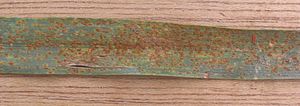 | Telium (redirect from Telial stage) There are a number of plants that can be infected by the telial stage. Therefore, the telial stage is considered a pathogen to those plants. A few specific... 3 KB (349 words) - 18:10, 6 February 2023 |
 | clavariiforme produces a set of orange tentacle-like spore tubes called telial horns. These horns expand and have a jelly like consistency when wet. The... 3 KB (227 words) - 04:49, 10 January 2024 |
 | family Pinaceae) and the telial hosts are those of the genus Ribes, specifically currants and gooseberries. Species of both telial and aecial hosts have... 19 KB (2,181 words) - 13:29, 24 April 2024 |
 | kind of plant but the telial stage on a different and unrelated plant), or single-host (autoecious) (i.e., the aecial and telial states on the same plant... 30 KB (3,320 words) - 08:10, 21 March 2024 |
 | several states of the United States of America because they are secondary (telial) hosts for white pine blister rust. Gooseberry bushes (Ribes) are hosts... 14 KB (1,620 words) - 13:55, 20 April 2024 |
 | resinosa), Ponderosa pine (P. ponderosa), and Scots pine (P. sylvestris). Telial hosts are Quercus species. Quercus hosts are generally made up of the red... 4 KB (465 words) - 23:44, 18 April 2024 |
 | Uromyces viciae-fabae var. viciae-fabae is a plant pathogen commonly known as faba-bean rust. The rust is distinguished by the typical rust-like marks... 7 KB (788 words) - 05:03, 10 January 2024 |
Chrysomyxa neoglandulosi is a fungus. It likely occurs wherever its telial host, Ledum glandulosum Nutt., is found. The only reported aecial host, Engelmann... 888 bytes (74 words) - 05:24, 19 April 2024 |
 | which they parasitize various species of Pinus (pine trees), while their telial occur on a number of angiosperms (flowering plants). Coleosporium asterum... 3 KB (194 words) - 06:58, 16 December 2023 |
 | diameter which produces a set of orange tentacle-like spore tubes called telial horns. These horns expand and have a jelly like consistency when wet. In... 14 KB (1,039 words) - 13:42, 5 January 2024 |
 | valuable. Because E. harknessii is an autoecious short-cycle rust lacking telial a host, there is no alternative hosts. The pathogen can infect actively... 17 KB (2,166 words) - 02:39, 16 March 2024 |
 | pustules on leaves, stems, petioles, and bracts. These darken into black, telial resting pustules once temperatures decrease. Flask-shaped pycnia appear... 8 KB (880 words) - 15:04, 10 January 2024 |
mature into a long columnar shape retaining the same color. The uredinial-telial stages of P. euvitis causes chlorotic and necrotic lesions ranging in shapes... 6 KB (823 words) - 00:22, 19 April 2024 |











